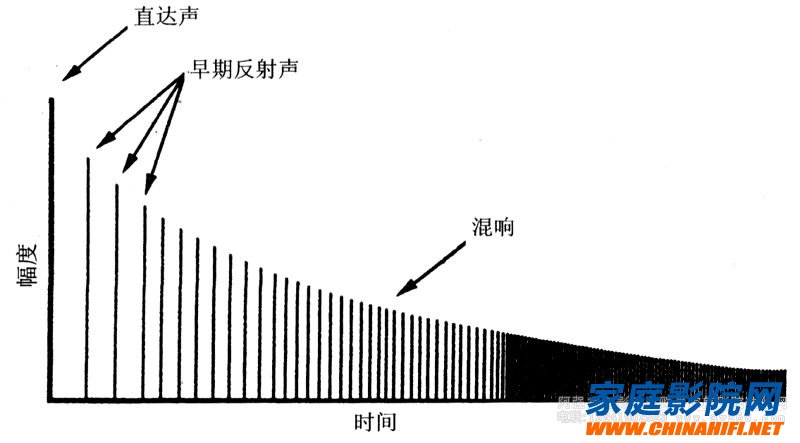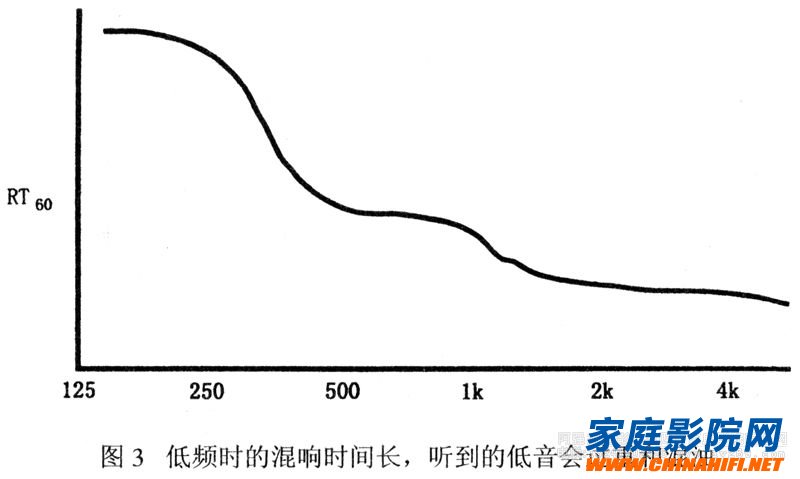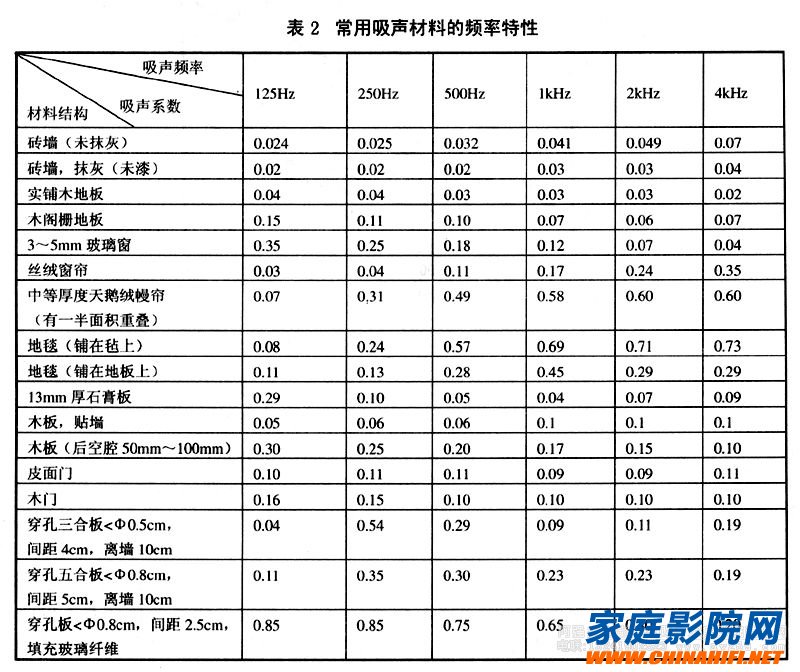
Figure 1 produces maximum sound pressure around the room. Reverberation is of course a fundamental component of sound. Although reverberation cannot be heard separately, reverb does add a sense of warmth and space to the music, and reverberation is indispensable. With proper reverberation, the music will be heard and the sound will be heard. If there is no reverberation when playing back music, the music you hear will be dry, dull and unnatural. Denon Japan has produced a CD of "Denon Anechoic Orchestral Recording (Denon PG 6006)". Because it is specially recorded in the silencer room where the reflection is absorbed. So when listening to the orchestra in the album, you will feel that the music is still indistinguishable from those recorded in even small professional studios. Dry, not pleasant and unnatural, but also very ugly.
The indoor reverberation will not disappear after a while (see Figure 1). The time required for the sound to attenuate 60 dB is the so-called indoor reverberation time RT60. The small sound-slowing RT60 for recording rock music studios may be only 0.1s; the cathedral's RT60 can be as long as 6~7s. The length of the indoor reverberation time can indicate how much the room is "active" or "silent." Usually, rooms with a slightly longer reverberation time are called "active." At this time, the proportional reflection sound of the direct sound and the reflected sound accounts for 20% to 30%. In such a room, the music is rich, soft and lively. The reflected sound in the room has less proportional sound, and the room with more sound absorption and shorter reverberation time is called “silentâ€. At this time, the proportional reflection sound of the direct sound and the reflected sound is only 5% to 10%. The music heard in this room is boring. Welcome to the home theater network The best reverberation time for a variety of rooms at a frequency of 500Hz is shown in Figure 2, and the reverberation time of some famous concert halls in the world can be seen in Table 1.


Figure 2 Optimal reverberation time for different rooms
Although the concept of reverberation is more used in large venues such as concert halls, it is rarely used in small spaces such as Hi-Fi listening rooms. But the reverberation can still come in handy in terms of sound absorption in the balance room. In a room with a reflective surface, the reverberation time is longer; in those rooms with carpets, soft furniture, and curtains hanging, the reverberation time is due to the fact that most of the sound waves are absorbed and the sound waves are not reflected. It will be shorter.
Different sound absorbing and scattering materials need to be selected in the listening room to achieve a comprehensive balance. Thereby the optimum reverberation time can be maintained substantially constant throughout the audio frequency band.
So, what better should the ideal reverberation time be in the listening room for listening to music? Speaking of it, the reverberation time should not be long, but it should not be too short. When the reverberation time is too short, the sound will sound dry, dull and unnatural, and the sound field seems to have been concentrated near the sound source, thus lacking the sense of envelopment and space; but when the reverberation time is too long, the sound will be too active, old The sound has not disappeared, and new sounds have appeared. Due to the mixing of sounds, the original sound is ambiguous, the details are seriously lost, and the audibility is greatly reduced. In addition, the reverberation time varies for different types of music. For light music, the reverberation time can be called shorter, while for large symphonies, the reverberation time can be slightly longer. The optimal ringing time of the listening room is related to the volume of the room. For a 250m3 room, the reverberation time is better than 0.9s, while for a large room of 570m3, the ideal reverberation time is 1.4s. As for the average family listening to music, the reverberation time is preferably 0.5~0.6s. You can use the method of clapping indoors or piercing a small balloon to accurately measure the reverberation time in the room. Clap your hands loudly or puncture a small balloon, then use the stopwatch to record the time between the start of the sound and the complete disappearance of the sound. By repeating several times and taking the average, you can measure the more reliable RT60 value.
However, just having one total optimal reverberation time is not enough. It should be managed to make the indoor reverberation time substantially the same value at all audio frequencies. So, how should the sound and reflection materials be combined to get the best reverberation time in the audio band? Laying thick carpets and thick curtains in the room can absorb some high frequencies, but it can't absorb low frequencies. Therefore, the reverberation time at a lower frequency will be longer than when the frequency is high. This situation is shown in Figure 3. Therefore, even with a Hi-Fi audio equipment, the bass will appear too heavy and slow while the music is playing back. Therefore, the reverberation time at six frequencies of 125 Hz, 250 Hz, 500 Hz, 1 kHz, 2 kHz, and 4 kHz is specified. It is hoped that the reverberation time at these six frequencies can be approximately the same. The realization of the dance is now a comprehensive method of using acoustic processing, that is, trying to select materials with different sound absorption characteristics as the frequency changes, and comprehensively utilize them. Now let's see what these sound absorbing materials will do for incident sound waves.

Every surface in the listening room will either absorb or reflect or diffuse (scatter) the sound waves. Let's take a look at the absorption and reflection of sound waves. The degree of surface sound absorption can be expressed by an absorption coefficient. The sound absorption coefficient is a measure of the percentage of sound absorption of the material at the specified six frequencies. A sound absorption coefficient of 1.0 means 100% absorption. For example, when the window is opened, the sound waves will not go back when they pass through the window. The sound absorption coefficient of 0.1 means 10% sound absorption, and another 90% of the sound energy is reflected back into the room. The sound absorption coefficient can even be greater than 1.0. For example, some wedge-shaped foam blocks, the area they present on the sound field is larger than the area in contact with the wall.
The frequency characteristics of some commonly used sound absorbing materials are shown in Table 2.

As can be seen from the above table, the carpet on the felt felt hardly absorbs sound at low frequencies, but the sound absorption at the frequency of 4 kHz is almost as high as 75%. Conversely, a 13mm thick gypsum board will absorb a significant portion of the low frequency (29%) at low frequencies, but will reflect most of the intermediate and high frequencies.
Assume further that the walls of the listening room and the ceiling and the floor are temporarily covered with a thick carpet. So it will absorb almost all the high frequencies and reflect almost all the low frequencies. Therefore, the reverberation time at high frequencies is short and the reverberation time at low frequencies is long. If you listen to music in such a room, you will hear thick, heavy and crowded bass. It makes people feel very uncomfortable. In addition, such a listening room will store the bass through resonance and then release it later, causing the transient signal to deteriorate, while the short-term reverberation time at the intermediate frequency and high frequency, together with the booming bass, will be more The sharpness is further reduced. If you turn the volume up a bit more, the situation will be even worse. In another extreme case, the interior walls are covered with thick plaster, the floor is covered with tiles and the room is not covered with any high-frequency sound absorbing material. Then you will hear too bright, blunt and thin voice. The trick of room acoustics is how to use the sound absorbing material ingeniously and reasonably so that the sound absorption can be roughly equal at six frequencies. In fact, it is difficult to have enough sound absorption at low frequencies. The reverberation time in most rooms is longer at low frequencies. Fortunately, in order to make the sound warmer, I hope that the reverberation time at low frequencies can be a little longer.
Indoor reverberation time is measurable. First, the sound absorbing system of the sound absorbing material at six frequencies is multiplied by the area (m 2 ) of the surface of the material, respectively . For example , if the area of ​​the carpet is 27m 2 , then 27 × 0.73 (the sound absorption coefficient of the carpet laid on the felt at 4 kHz) will have 19.7 sound absorption units (called Sabine sound absorption units). The sound absorption units of the other five frequencies are calculated in turn. Such calculations should be made for each type of sound absorbing material. The reverberation time is calculated according to the following formula proposed by American physicist Wallace Clement Sabine: RT 60 =0.163V/Sα av where RT 60 is the reverberation time ( s); V is the volume of the room (m 3 ); S is the total area of ​​the indoor surface (m 3 ); α av is the average sound absorption coefficient of Sabine.
Sabine's formula is more accurate for larger rooms (assuming that the sound absorbing material is evenly laid throughout the listening room), but still gives people the ability to achieve a sound-absorbing balance between low and high frequencies. Revelation. If you find that there is a large difference in the total Sabine sound absorption unit calculated between 125 Hz and 4 kHz, it means that you should try to add some materials that absorb the bass to be able to average the reverberation time. The acoustically processed materials that were introduced earlier in this chapter can be used to try to make the reverberation time consistent over the audio rate range.
Powered Subwoofer,Aluminum Cone Woofer,Indoor Active Subwoofer,Home Theater Subwoofer
The ASI Audio Technology Co., Ltd , https://www.asi-sound.com
